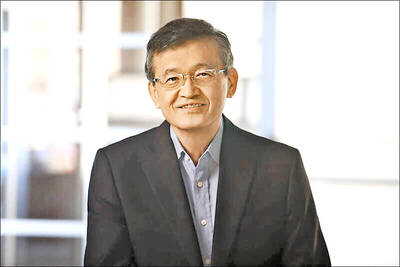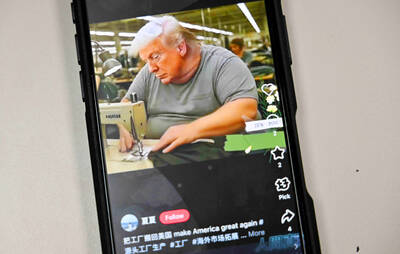The rapid appreciation of the Chinese currency against the US dollar is taking a big toll on Asian companies using China as a base for exports to the US, a top US business official said.
The yuan has risen 18 percent against the dollar since China abandoned a peg in July 2005, and the currency breached a key psychological level of 7 yuan to US$1 on April 10.
The higher yuan makes US exports more competitive with Chinese goods in their home market, while business costs for largely Asian companies producing and exporting from China will rise as they pay more local currency for labor and raw materials and sell their products to the US market in dollars.
Meanwhile US firms manufacturing inside China, most of which aim their goods for the huge Chinese domestic market, are not as greatly affected, said US-China Business Council president John Frisbie.
“I think it is probably a bigger issue for all those companies from other economies in Asia that have invested in China for the US market,” he said. “And that’s companies from Japan, [South] Korea, Taiwan, Hong Kong, Malaysia and Singapore.”
Frisbie said many Asian companies selling to the US market had shifted their production to China over the last 10 years or so to be more cost-competitive.
“I’m sure for them, the exchange rate change and other cost increases happening in China now are having an impact. That is a different set of companies than US companies, most of which invested in China for the China market,” he said.
Aside from the falling dollar, the Asian companies are also reeling from the effects of a weakening US demand on the back of an economic slowdown, reports said.
The dollar has fallen about 4 percent to the yuan so far this year, after dropping 7 percent last year.
The yuan’s rise, partly permitted by Beijing to contain soaring inflation, is a bit of an irony.
Beijing has been accused for years by Washington of controlling the yuan’s direction and keeping it low against the dollar to make Chinese goods more competitive in the global market.
US lawmakers particularly had threatened to impose sanctions on China as the US trade deficit with the world’s most populous nation sank deeper into the red.
Frisbie said that his council’s view on the yuan exchange rate had been consistent in that “the best determinant of its true value should be the market.”
The prices of China-made goods in the US have gone up, but not as much as the yuan appreciation, while Chinese exports are growing much less rapidly, said Nicholas Lardy, a China expert at the Washington-based Peterson Institute for International Economics.
Lardy said while the salience of the yuan issue in the US Congress had diminished amid the Chinese currency’s appreciation, the “underlying concern” over China’s massive current account surplus remained.
“We should not be looking at the bilateral renminbi [yuan]-dollar rate but at the renminbi vis-a-vis a trade-weighted basket of currencies of China’s trading partners,” he said.
Since mid-2005, the yuan has appreciated by 18 percent against the dollar but “it only rose by 10 percent on a trade weighted basis and this is not going to make a dent on that massive surplus,” Lardy said.
China recorded an enormous current account surplus of US$378 billion last year, or 12 percent of its GDP.

Intel Corp chief executive officer Lip-Bu Tan (陳立武) is expected to meet with Taiwanese suppliers next month in conjunction with the opening of the Computex Taipei trade show, supply chain sources said on Monday. The visit, the first for Tan to Taiwan since assuming his new post last month, would be aimed at enhancing Intel’s ties with suppliers in Taiwan as he attempts to help turn around the struggling US chipmaker, the sources said. Tan is to hold a banquet to celebrate Intel’s 40-year presence in Taiwan before Computex opens on May 20 and invite dozens of Taiwanese suppliers to exchange views

Application-specific integrated circuit designer Faraday Technology Corp (智原) yesterday said that although revenue this quarter would decline 30 percent from last quarter, it retained its full-year forecast of revenue growth of 100 percent. The company attributed the quarterly drop to a slowdown in customers’ production of chips using Faraday’s advanced packaging technology. The company is still confident about its revenue growth this year, given its strong “design-win” — or the projects it won to help customers design their chips, Faraday president Steve Wang (王國雍) told an online earnings conference. “The design-win this year is better than we expected. We believe we will win

Chizuko Kimura has become the first female sushi chef in the world to win a Michelin star, fulfilling a promise she made to her dying husband to continue his legacy. The 54-year-old Japanese chef regained the Michelin star her late husband, Shunei Kimura, won three years ago for their Sushi Shunei restaurant in Paris. For Shunei Kimura, the star was a dream come true. However, the joy was short-lived. He died from cancer just three months later in June 2022. He was 65. The following year, the restaurant in the heart of Montmartre lost its star rating. Chizuko Kimura insisted that the new star is still down

While China’s leaders use their economic and political might to fight US President Donald Trump’s trade war “to the end,” its army of social media soldiers are embarking on a more humorous campaign online. Trump’s tariff blitz has seen Washington and Beijing impose eye-watering duties on imports from the other, fanning a standoff between the economic superpowers that has sparked global recession fears and sent markets into a tailspin. Trump says his policy is a response to years of being “ripped off” by other countries and aims to bring manufacturing to the US, forcing companies to employ US workers. However, China’s online warriors